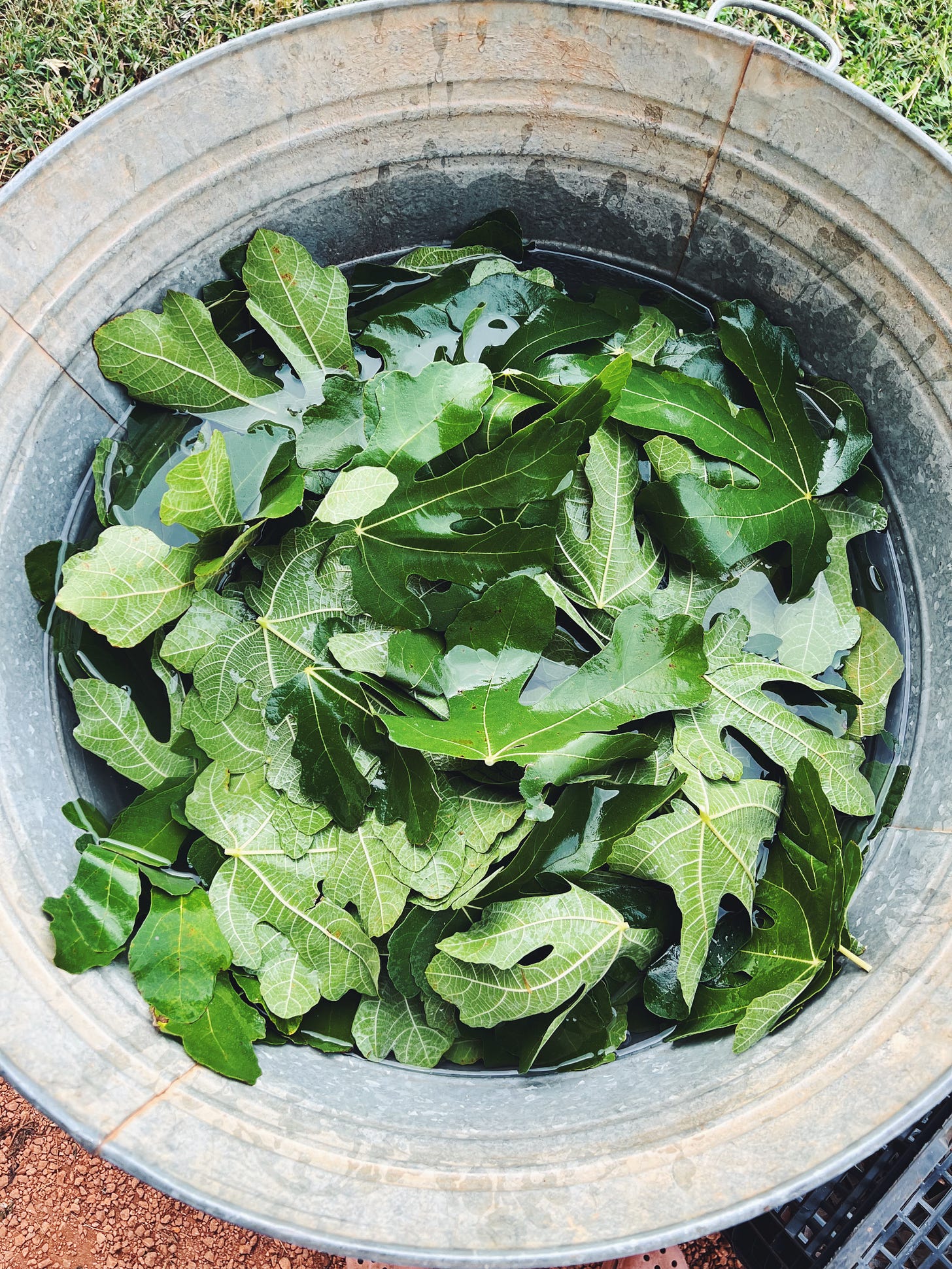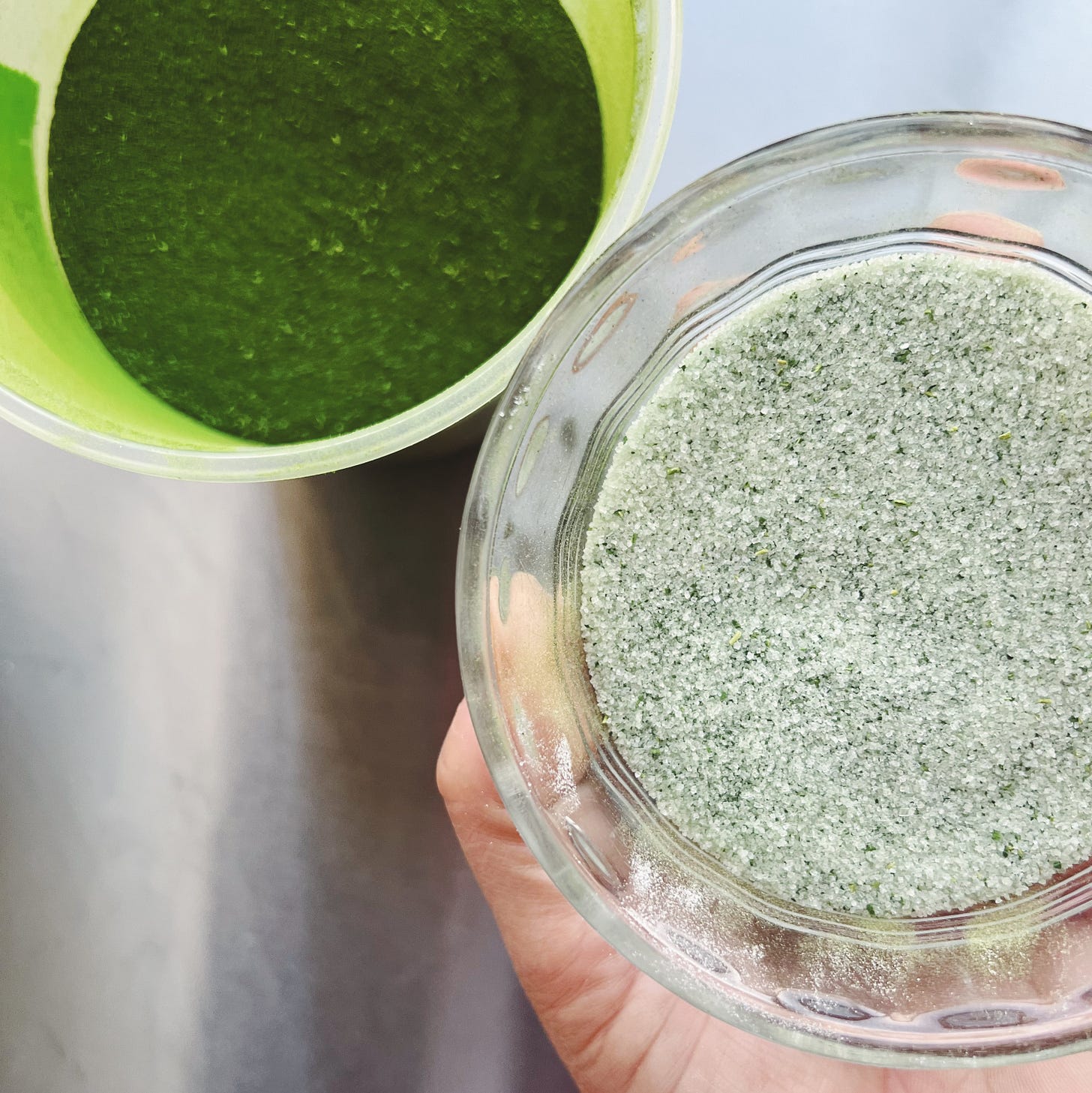Fig leaves are all the rage in the pastry world. My feed is rife with folks making use of this ingredient. From fluffy roll cakes and vinegars, I see the inconspicuous fig leaf (that is, if one is accustomed to only paying attention to the fruit of the fig tree) being celebrated for its unique flavor. When heated or toasted, fig leaves emit a coconut-like essence that can be used to infuse foodstuffs with a surprisingly tropical flavor. Depending on what they are paired with, fig leaves can have notes of green and bend toward the floral too.
I’m sure I first learned of fig leaves from one of my favorite internet cake girls, though I can’t remember who exactly. The best thing about it was that I could walk outside to my own baby fig trees and clip a few leaves. Food is everywhere.
When we moved to the farm in 2019, my husband and I immediately planted two fig trees of our own. Since then they’ve grown in terribly slow fashion. I contemplated moving the trees to a new spot (I was told fig trees are quite resilient, fine to be yanked out of the ground and planted elsewhere) but then they had a noticeable growth spurt this year. Still, no fruit.
But there were leaves and I’ve put them to use by making fig leaf powder which I’ve turned into fig leaf sugar, tossed into cake batters, peach jam (highly recommend!), pastry cream, and cookies (recipe below). For a Pie Party on the farm, I made a blackberry slab pie with fig leaf pastry cream. And when I went to Savannah, Georgia to teach a pie workshop with fellow bakers Cheryl Day and Nicole Rucker, I brought a jar of fig leaf powder that Nicole added to an apple pie. It harmonized so well, it’s a flavor I crave. If you’re a farmers market customer, you’ve benefited from this flavor affinity.
My enthusiastic use of fig leaves this season has garnered interest from more than a few folks. The more I talked about it online, the more I received text messages and DM’s from folks, including chefs, who didn’t know they could be used. Though my pastry-centric algorithm fed me all the late summer fig leaf content, I discovered there were more people who wanted to know about how to use fig leaves.
Below is a short primer for making your own fig leaf powder and fig leaf sugar followed by an easy sugar cookie recipe that uses the powder in the cookie batter and the sugar in a decorative coating for the cookie.
To make your own fig leaf powder:
+ Harvest the leaves from the tree. I use a pair of scissors to clip the leaf from its stem end. Fig trees do emit a milky white latex which can irritate the skin, so try to avoid getting the sticky substance on your hands. Fun fact: That latex can be dried and powdered and used to coagulate milk for cheesemaking.
+ Wash the leaves.
+ Dry the leaves in the oven. Preheat the oven to 300 degrees. Place fig leaves on a sheet pan and toast until dry, about 10-12 minutes. It’s okay to overlap the leaves on the sheet pan to fill it up, just don’t stack them in layers. The fig leaves will be undeniably dry and crackly. Your house will smell like heaven.
+ Buzz into a powder. Hold the stem end and remove the dried leaves from any tough, veiny parts of the leaf. Add the leaves into a blender, food processor, or spice grinder and buzz into a fine powder.
+ Sift and store. Pass the powder through a fine mesh strainer for a more refined powder. This also filters out any leaves or stemmy parts that didn’t blend well. Store in an airtight container.
To make your own fig leaf sugar:
½ cup granulated sugar
2 teaspoons fig leaf powder
1 tablespoon sparkly sugar (optional)
Combine all ingredients into a small bowl and mix well. Use to coat the cookies in recipe below, or save for other baking projects. It’s wonderful sprinkled across a pie top.
Fig Leaf Sugar Cookie
Fig leaf powder adds notes of vanilla to a simple sugar cookie recipe with the perfect chew, and fig leaf sugar lends a pleasing green tint to the decorative coating. It’s still the sugar cookie you love, but with a little intrigue.
This recipe is slightly adapted from a recipe in the Desserts Illustrated book. The original recipe recommends portioning the cookies two tablespoons at a time for 24 cookies, but I like a cookie the size of your face. A #16 scoop (2oz) will yield 11 large cookies.
2¼ cups (319g) all-purpose flour
2 teaspoons fig leaf powder
1 teaspoon baking powder
½ teaspoon baking soda
¾ teaspoon kosher salt
1½ cups sugar (300 g) plus ½ cup fig leaf sugar
4 tablespoons (57g) cream cheese, cut into 8 pieces
6 tablespoons (85g) unsalted butter, melted and still warm
⅓ cup vegetable oil
1 large egg
1 tablespoon whole milk
2 teaspoons vanilla extract
Preheat oven to 350 degrees. Line 2 baking sheets with parchment paper. Whisk together flour, fig leaf powder, baking powder, soda, and salt.
In a large bowl, add 1½ cups sugar and cream cheese. Whisk in warm butter, using the whisk to break up any remaining large pieces of cream cheese. Whisk in oil, then egg, milk, and vanilla.
With a spatula, fold in flour mixture until a soft homogenous dough forms. Place fig leaf sugar in a separate bowl.
Portion the cookie dough into 2 oz. portions. You can use a #16 scoop if you have it. Roll the portioned dough into a ball and coat with fig leaf sugar by rolling it in the prepared bowl. Place dough balls 2 inches apart on the parchment-lined sheet pan . Use the bottom of a 1 cup measuring cup to press the dough balls into a circle. I recommend giving these cookies plenty of space on the sheet pan, being careful not to place them to close to the baking sheet edge lest they butt up against it and lose their shape. A perfectly round sugar cookie is a thing of beauty.
One sheet at a time, bake cookies in the center rack of the oven for 11 to 13 minutes, rotating halfway through. The cookies will spread and take on the slightest bit of color around the edges. Let cookies cool for 5 minutes before handling. They will be too pliable at first, but will settle into a perfectly chewy sugar cookie once cooled.
More links! Go down the fig leaf rabbit hole:
+ All About Fig Leaves from Kitchen Projects, one of my favorite Substacks by Nicola Lamb
+ Fig Leaf Sugar and Pastry Cream from cake sweetie, Sasha Piligian
+ The Splendid Table digs into smoked fig leaves.






Agree! Thanks so much for this! My neighbor has a chicago fig (a hardier variety) and now I am more empowered to ask her for a few leaves to experiment with.
Thanks for posting all of this beautiful info about the fig leaf! I have been living in Greece for so long with fig trees all around us and we didn't know about these uses of the leaves. We do so many things with the figs but the leaves? Never. The fig trees here are abundant. I will definitely spread the word, Im sure that so many people here would be interested to see what the fig leaves could do!!!!